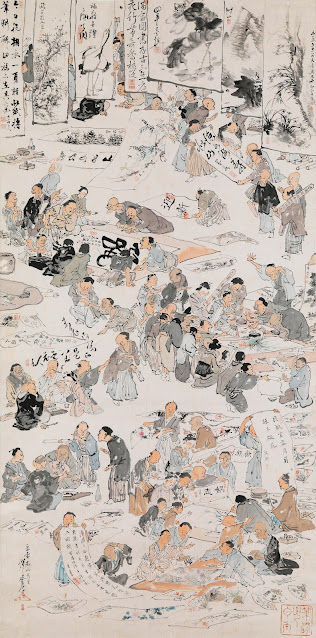Kyosai at the Royal Academy on the 21st, April 2022
Kawanabe
Kyosai (1831-1889 is regarded as the successor in Japanese art to Katsushika
Hokusai (1760-1849) who helped to shape the Ukiyo-e (floating world)
painting style. Whereas Japan had been
relatively isolated from the outside world for 260 years,
Kyosai witnessed the arrival of the first western fleet and increasing
Westernisation.
This
was initiated by the Meiji dynasty in 1868 when the Tokugawa shogunate was
toppled and imperial power restored after centuries of decline. The emperor had come to represent spiritual
power whereas, the Shogun (meaning roughly ‘army commander’) the secular, military
power of the Japanese state. Although
the Shogun was technically the emperor’s servant, the emperor had been
marginalised and deprived of significance for centuries. The Meiji restoration signified the decline
of the shogunate. The emperor moved his
seat of power from Kyoto to Edo, formerly the capital of the shogunate,
re-naming it Tokyo.
Meiji,
meaning Enlightened Rule, represented a historic alteration in Japanese foreign
and domestic policies. Regional
landlords or daimyos voluntarily surrendered their land to the emperor and
increasing reliance on Western experts and Western products like meat and beef
became a new normal.
Kyosai,
therefore, lived in turbulent times. He
initially studied under Utagawa Kuniyoshi (1798-1861) an adept of the ukiyo-e
(floating world) style. Ukiyo-e had
different connotations, meaning “erotic” or “stylish” and signified “living for
the moment…like a gourd carried along by the river current.” (Asai Ryoi, Ukiyo
Monogatari – Tale of the Floating World, 1661). After studying under Kuniyoshi, Kyosai then
studied in the Kano school, the dominant school of art in Japan organised by
the shogunate and the samurai. It was
here that Kyosai learnt to incorporate Kano-style ink techniques into his
drawings.
In
Night Procession of 100 Demons (1871/89, ink and gouache on paper) an
ancient Japanese tradition that stated that household items more than
100 years old are transformed into demons that come out at night and are
vanquished at sunrise. Pots, potlids,
and plates protrude from the demons. Thick,
austere black lines are complimented by pastel shades of blue, pink, and grey.
Many
of Kyosai’s works represent the natural world, such as Egrets over lotus
pond in the rain (1871/89, ink on paper).
Works like this evoke the traditional stillness and minimal concentration
of a Japanese haiku. In other paintings like
Fashionable picture of the Great Frog Battle (1864, colour woodblock
print triptych), the battle at the Hamaguri Gate of the Imperial Palace in
Kyoto which led to the overthrow of the Tokagawa shogunate, the use of animals
allowed Kyosai to evade censorship.
Comic
and satirical effects began to appear in Kyosai’s art, especially in relation
to the increasing Westernisation which was occurring in later 19th
century Japan. In Skeleton Shamisen
player in top hat with dancing monster (1871/78, ink and light colour on
paper), Westernisation is the target.
People may wear different disguises, such as top hats, Kyosai intimates,
but a samurai sword still sticks out from behind the skeleton. The artist seems to say that tradition will
overcome modernisation. Other
encroachments, such as the arrival of Christianity, are satirised in Kyosai’s
work Five Holy Men (1871/87, ink and light colour on paper) where Christ
is depicted on the cross waving a Japanese fan.
Attempts
to satirise Western fashions and customs did not stop Kyosai from incorporating
Western techniques such as perspective, shading, and the study of anatomy, into
his paintings. In works like A Beauty
in front of King Enma’s mirror (1871/89, ink colour and gold on silk)
Kyosai broke with convention by using a complex technique to depict comic
content.
Erotic
and satirical, religious, and secular, Kyosai’s paintings depict a world in
flux where static symbols and tradition itself, were beginning to be
questioned. This exhibition is an
excellent accompaniment to the British Museum’s recent Hokusai exhibition. In the late nineteenth century Japanese art
was beginning to capture the attention of Western artists like Van Gogh and
Paul Gaugin who began to incorporate Japanese elements into their own painting. This exhibition shows us how influence was
also flowing in the opposite direction.
Paul
Murphy, Royal Academy, April 2022











Comments